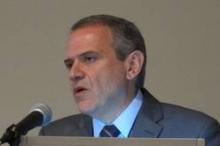NEW YORK – Patients with panic disorder can be effectively treated with either a benzodiazepine or a selective serotonin reuptake inhibitor, or both, but even long-term therapy might not prevent relapse in the majority of patients.
That’s the conclusion of a team of Brazilian researchers who compared clonazepam, paroxetine, and a combination of the two in patients with panic disorder in a randomized, open-label trial.
By the third year of follow-up, about 77% of patients had experienced a relapse despite being treated for 3 years, and after 6 years, 94% of patients had experienced at least one new panic attack, reported Dr. Antonio E. Nardi of the Federal University of Rio de Janeiro.
However, resumption of therapy with either drug or with a different medication was successful in preventing or reducing the incidence of additional attacks in nearly all patients.
"We propose to discontinue drug treatment as soon as patients are asymptomatic for 1 year and to restart treatment at the first sign of relapse," he said at the annual meeting of the American Psychiatric Association.
The good and the bad
The benzodiazepine clonazepam and the SSRI paroxetine each have their advantages and drawbacks, Dr. Nardi said.
Clonazepam has a rapid onset of action, decreases anticipatory anxiety, and has a good safety profile in terms of interactions and overdose risk. On the other hand, patients might experience withdrawal symptoms, develop memory problems, and become dependent on the agent.
Paroxetine has well documented antidepressive effects and little if any potential for abuse but can cause sexual dysfunction, hyperstimulation, anticholinergic effects, and weight gain.
With either agent, from 20% to 40% of patients remain symptomatic after short- or intermediate-term treatment, and relapse is frequent, even after 1 year of treatment, Dr. Nardi said.
The investigators designed an open-label clinical trial in which patients would be randomized to either clonazepam 2 mg/day or paroxetine 40 mg/day. Those who did not respond well to either drug were switched after 8 weeks to a combination of the drugs at or near the dose levels assigned for the individual drugs.
After the 8-week efficacy phase, patients were followed for safety and efficacy of both agents and the combination during 3 years of continuous treatment. Patients were tapered off drugs at 3 years and followed up through 6 years for the number of panic attacks per month, clinical global impression severity score (CGI-S), and Hamilton Anxiety Scale score (HAM-A).
Of the 120 patients enrolled, 94 completed the 3 years of treatment (45 on clonazepam, 33 on paroxetine, and 16 on the combination). In all, 66 of these patients had annual assessments out to 6 years; the remaining 28 had assessments at 5 or 6 years of follow-up. Among the 66 patients who were seen annually, relapse rates were 41% 1 year after therapy taper was completed, 77% at 4 years, and 94% at 6 years.
For most patients, restarting the original drug resulted in either a partial remission (54%) or full remission (36%). With treatment resumption, 73% of patients remained free of panic attacks, 91% had a CGI-S score of 1 (very much improved), and 39% had a HAM-A score from 5 to 10, indicating low anxiety.
Both drugs were generally well tolerated, although clonazepam was associated with significantly fewer adverse events, including drowsiness/fatigue, sexual dysfunction, nausea/vomiting, appetite/weight change, dry mouth, hyperhydrosis, and diarrhea/constipation, compared with paroxetine, in all but one category. No significant differences were found between the two drugs in their effects on memory and concentration, however.
The study was supported by the Brazilian Council for Scientific and Technological Development, and Brazil\'s National Institute for Translational Medicine. Dr. Nardi disclosed serving on advisory boards for Aché, CNPq, GlaxoSmithKline, Grupo A, and Lundbeck, and serving on the speakers bureaus for Solvay, Cristalia, GSK, Roche, and Aché.

